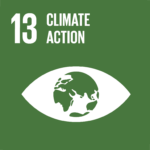Faced with climate challenges and diminishing yields, many farmers in the Bangladesh’s southwestern coast region are returning to agriculture, prioritizing crop diversity and sustainable practices to combat soil salinity and adapt to a changing climate.
Satkhira, Bangladesh — Along the southwest coast of Bangladesh, a quiet revolution is reshaping agriculture. Farmers who once relied on shrimp farming, an industry plagued by environmental degradation and diminishing returns, are transitioning back to traditional crops and diverse agricultural practices to combat soil salinity and adapt to the impacts of climate change.
RELEVANT SUSTAINABLE GOALS




A Return to Agriculture
For decades, shrimp farming dominated Bangladesh’s coastal districts, with farmers like Sheikh Sirajul Islam of Satkhira’s Shyamnagar upazila investing heavily in marine water enclosures, locally called ghers. However, after years of declining shrimp yields due to viral outbreaks and soil salinity, Sirajul made the switch back to rice cultivation.
“Now, I cultivate rice during the monsoon season and vegetables or fruits in the dry season on the same land that was exposed to high salinity earlier,” Sirajul explained.
This shift is part of a larger trend among farmers in districts like Satkhira, Khulna, and Bagerhat. By diversifying crops—including rice, watermelon, sunflower, mustard, and maize—they are optimizing their land throughout the year, enhancing both productivity and resilience.
The Collapse of Shrimp Farming
Shrimp farming, which boomed in the 1980s as rising salinity made rice farming difficult, is now in decline. Farmers like Nirmal Gayen of Dakop, Khulna, who once relied on shrimp aquaculture, have faced frequent losses due to cyclones, flooding, and viral outbreaks.
“The last time I cultured shrimp, I could only recover half of the $705 I had invested,” Nirmal recalled. He has since shifted to rice-watermelon farming, which has proven more profitable and sustainable.
Between 2018 and 2023, shrimp production in Bangladesh dropped by over 7%, with Khulna alone experiencing an 8% decline. Shrimp farming coverage shrank by nearly 5% during the same period, as more farmers opted for traditional agriculture.
Crop Diversification: A Climate Adaptation Strategy
In a region vulnerable to sea-level rise, cyclones, and soil salinization, crop diversification has become a key strategy for smallholder farmers. A study conducted in Dakop found that rice-watermelon farming yielded higher gross benefits and net income than shrimp farming alone.
“By preventing salinity intrusion, farmers are producing food for their families and restoring greenery to their near-deserted environment,” said environmental scientist Abdullah Harun Chowdhury of Khulna University.
Despite these gains, challenges persist. Surface water salinity peaks from February to April, coinciding with the dry season. Farmers rely on temporary embankments to block saline water from entering their fields and store rainwater for irrigation, but water scarcity remains a pressing issue.
Addressing Water Scarcity
“An acute water shortage persists here during summer,” Sirajul noted. “Whatever little water remains available in rain-fed ponds and canals, we use it for watering the growing crops. But sometimes, even that becomes unmanageable.”
Experts suggest long-term solutions, such as rejuvenating small rivers and canals to capture rainwater during the monsoon season.
“Continuous monitoring and regular assessment and adjustments to these strategies are essential in mitigating the long-term effects of sea-level rise and saltwater intrusion,” said Mohammad Shamsudduha, a professor at University College London.
While water scarcity and environmental challenges remain, the success of farmers like Sirajul and Nirmal offers hope for a sustainable future. As climate change continues to reshape livelihoods in Bangladesh, the region’s agricultural transformation could serve as a model for other vulnerable coastal areas worldwide.
Lead image courtesy of L Noor A .Alam.
You may also be interested in :
In Indonesia’s Indragiri Hilir, Climate Change Forces Farmers turn To Mangroves and Fishing





